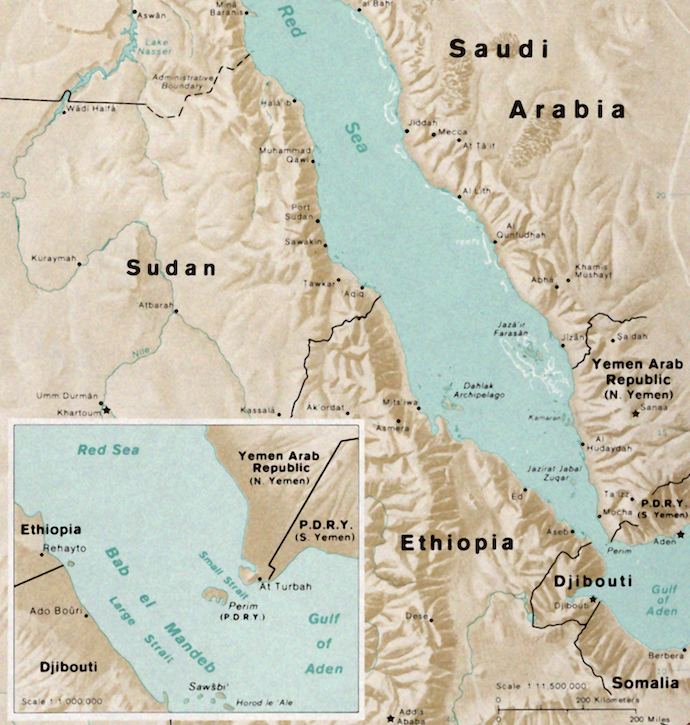The Platform
Latest Articles
by Sehr Rushmeen
by Gordon Feller
by James Carlini
by Muhammad Zain Ul Abdin
by Ismaila Biliaminu Manne
by Ismaila Biliaminu Manne
by Arth Agarwal
by Sohail Mahmood
by Sehr Rushmeen
by Iqra Awan
by Sehr Rushmeen
by Gordon Feller
by James Carlini
by Muhammad Zain Ul Abdin
by Ismaila Biliaminu Manne
by Ismaila Biliaminu Manne
by Arth Agarwal
by Sohail Mahmood
by Sehr Rushmeen
by Iqra Awan
The Red Sea Has Turned into a Battlefield, Explained
Despite the U.S. military entering the fray, the Houthis are unlikely to be discouraged from launching further attacks in the Red Sea.
In a significant shift in regional dynamics, the already volatile situation between Houthi insurgents and the United States has escalated into open hostility. The epicenter of this latest surge in tension is the Bab el-Mandeb Strait, a crucial juncture south of the Red Sea, which has now become an arena of strategic military importance. This confrontation traces its roots to the October 7 offensive by Hamas against Israel, which led to the Houthis launching missile and drone attacks toward southern Israel.
The Houthis maintain that their attacks are in solidarity with Hamas’s resistance against Israel. Yet, some analysts suggest that these actions aim to achieve broader objectives: the Houthis seek to claim victories in the court of public opinion and to strengthen their claim of sovereignty over the territories under their control.
Emerging from northern Yemen, the Houthis, a Shiite minority, have long benefited from the support of Iran. This relationship casts them in a light similar to that of Lebanese Hezbollah and Shiite militias in Iraq, viewed by many as extensions of Iranian geopolitical strategy. The Houthi advance into Sana’a on September 21, 2014, which culminated in the ousting of the Yemeni government, compelled Saudi Arabia—with American backing—to form a coalition in support of Yemen’s internationally recognized government.
The ongoing Houthi revolt has led to catastrophic outcomes for Yemen, sparking a brutal civil war and displacing over five million people, both internally and beyond Yemen’s borders. The country also grapples with widespread poverty and famine, conditions worsened by a stringent blockade. Despite these humanitarian crises, the Houthis have chosen to invest heavily in advanced weaponry, a decision widely criticized as both reckless and inhumane.

The historical backdrop of the 1960s and 1970s sets a precedent, with Palestinian factions then leveraging the Bab el-Mandeb Strait to disrupt international maritime routes to Israel, abetted by the governments of both North and South Yemen. Egyptian President Gamal Abdel Nasser similarly exploited this strategic channel to besiege Israel, erecting military bases to monitor and control maritime traffic in collaboration with the leadership of North and South Yemen.
The current surge in Houthi activity within the Bab el-Mandeb Strait has garnered the attention and concern of major global powers, most notably the American and British governments. In a departure from previous threats to maritime navigation, the Houthis have now seized a vessel owned by an Israeli businessman and have declared their intention to detain all Israeli-affiliated ships, alongside any vessels en route to Israel. This aggressive stance, they assert, supports the people of the Gaza Strip. The Houthis have pledged to continue their maritime assaults on shipping lanes to Israel until the conflict ceases and the blockade on Gaza is lifted. Consequently, these actions have led to direct encounters with U.S. and allied naval forces in the southern Red Sea.
Ignoring a UN Security Council resolution calling for an end to their maritime threats and disregarding warnings from the United States and its allies, the Houthis have compelled the U.S. and its allies to establish a military coalition. This alliance has reacted with precise strikes on Houthi military locations, sinking three of their naval vessels and targeting Houthi strongholds in Sana’a, Taizz, Al Hudaydah, Hajjah, and Al Bayda’. Statements from U.S. and UK officials articulate that these strategic strikes aim to deter Houthi aggression and dismantle their capacity to threaten international shipping. However, the effectiveness of this campaign in achieving its goals remains uncertain.
The latest skirmish in the southern reaches of the Red Sea has laid bare the shortcomings of U.S. strategy. Instead of opting for direct confrontation, a more tactically astute approach for the Biden administration would have been to bolster the Houthi opposition. Financial support and the provision of sophisticated armaments to the Houthi adversaries might have offered a more successful outcome. It’s the local forces, after all, who possess the intrinsic capability to defeat the Houthis. By equipping these local forces with state-of-the-art weaponry, the U.S. could effectively empower them to reclaim Sunni-dominated territories now under Houthi control, including Al Hudaydah. This port city has become a critical juncture for the Houthis, serving as a launchpad for their aggressive maneuvers against international vessels traversing the southern Red Sea. The current U.S. policy only serves to inadvertently elevate the Houthis’ stature, granting them a veneer of legitimacy and a surge in popularity—locally, regionally, and on the world stage.
Abdo Al-Bahesh is with the NCHR as part of the 'Scholars at Risk' program at the University of Oslo.
